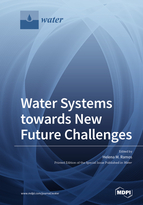Water Systems towards New Future Challenges
A special issue of Water (ISSN 2073-4441). This special issue belongs to the section "Water Resources Management, Policy and Governance".
Deadline for manuscript submissions: closed (31 December 2016) | Viewed by 106578
Special Issue Editor
Interests: hydropower; hydraulic transients; pumped-storage; water and energy nexus; hydrodynamic; renewables integration; water-energy efficiency
Special Issues, Collections and Topics in MDPI journals
Special Issue Information
Dear Colleagues,
Water supplies (WS) collect, store and/or treat, and distribute water among water sources and consumers. They are the transfer of drinking, irrigation, waste, storm and industrial water from an intake to final users. This important infrastructure is becoming a dynamic environment, where new technologies and the best practices are implemented with the ambition of increasing the safety, efficiency, sustainability and management.
The monitoring system (MS), control technology (CT), management strategy (MS), energy saving (ES), eco-innovative solution (EIS), and modeling decision support system (MDSS) have to be improved to obtain technical, economic and environmental benefits in terms of research, technology and engineering applications.
Therefore, a sustainable water-energy nexus (WEN) rises in terms of its water and energy efficiency, reliability and environmental integration towards smart water grids (SWG). This is a new way for smart technology, resource management and sustainable water infrastructures developments in a near future to face climate and demand challenges.
Prof. Dr. Helena Margarida Ramos
Guest Editor
Manuscript Submission Information
Manuscripts should be submitted online at www.mdpi.com by registering and logging in to this website. Once you are registered, click here to go to the submission form. Manuscripts can be submitted until the deadline. All submissions that pass pre-check are peer-reviewed. Accepted papers will be published continuously in the journal (as soon as accepted) and will be listed together on the special issue website. Research articles, review articles as well as short communications are invited. For planned papers, a title and short abstract (about 100 words) can be sent to the Editorial Office for announcement on this website.
Submitted manuscripts should not have been published previously, nor be under consideration for publication elsewhere (except conference proceedings papers). All manuscripts are thoroughly refereed through a single-blind peer-review process. A guide for authors and other relevant information for submission of manuscripts is available on the Instructions for Authors page. Water is an international peer-reviewed open access semimonthly journal published by MDPI.
Please visit the Instructions for Authors page before submitting a manuscript. The Article Processing Charge (APC) for publication in this open access journal is 2600 CHF (Swiss Francs). Submitted papers should be well formatted and use good English. Authors may use MDPI's English editing service prior to publication or during author revisions.
Keywords
- Smart water
- Water-energy nexus
- Energy efficiency
- Safety and control systems
- Sustainable water management






